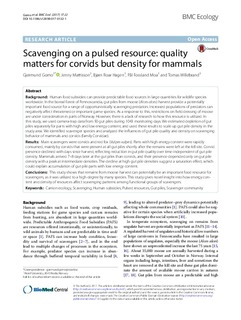Scavenging on a pulsed resource : quality matters for corvids but density for mammals
Journal article, Peer reviewed
Published version

Åpne
Permanent lenke
http://hdl.handle.net/11250/2446430Utgivelsesdato
2017Metadata
Vis full innførselSamlinger
Originalversjon
Gomo, G., Mattisson, J., Hagen, B. R., Moa, P. F. & Willebrand, T. (2017). Scavenging on a pulsed resource: quality matters for corvids but density for mammals. BMC Ecology, 17: 22. doi: 10.1186/s12898-017-0132-1Sammendrag
Background: Human food subsidies can provide predictable food sources in large quantities for wildlife species worldwide. In the boreal forest of Fennoscandia, gut piles from moose (Alces alces) harvest provide a potentially important food source for a range of opportunistically scavenging predators. Increased populations of predators can negatively affect threatened or important game species. As a response to this, restrictions on field dressing of moose are under consideration in parts of Norway. However, there is a lack of research to how this resource is utilized. In this study, we used camera-trap data from 50 gut piles during 1043 monitoring days. We estimated depletion of gut piles separately for parts with high and low energy content, and used these results to scale up gut pile density in the study area. We identified scavenger species and analyzed the influences of gut pile quality and density on scavenging behavior of mammals and corvids (family Corvidae).
Results: Main scavengers were corvids and red fox (Vulpes vulpes). Parts with high energy content were rapidly consumed, mainly by corvids that were present at all gut piles shortly after the remains were left at the kill site. Corvid presence declined with days since harvest, reflecting reduction in gut pile quality over time independent of gut pile density. Mammals arrived 7–8 days later at the gut piles than corvids, and their presence depended only on gut pile density with a peak at intermediate densities. The decline at high gut pile densities suggest a saturation effect, which could explain accumulation of gut pile parts with low energy content.
Conclusions: This study shows that remains from moose harvest can potentially be an important food resource for scavengers, as it was utilized to a high degree by many species. This study gives novel insight into how energy content and density of resources affect scavenging patterns among functional groups of scavengers.
Keywords: Carrion ecology, Scavenging, Human subsidies, Pulsed resources, Gut piles, Scavenger community
